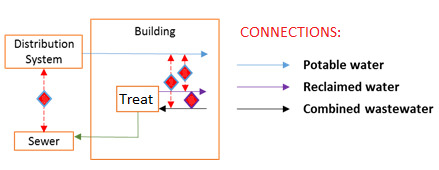Human Health Impact of Cross-Connections in Non-Potable Reuse Systems
Abstract
:1. Introduction
2. Materials and Methods
2.1. Literature Review
2.2. Pathogen Health Impact
2.2.1. QMRA
- S is the fraction of people in the exposed population susceptible to each reference pathogen
- DR(...) is a dose-response function for the reference pathogen
- DF is the dilution factor (i.e., the total volume of water in which the intrusion is mixed)
- V is the volume of water ingested per day
- n is the number of days of exposure
- C is the pathogen concentration in the wastewater or greywater
- LRT is the total log reduction target for each reference pathogen
- fr is the cross-connection exposure fraction (i.e., exposed users/total users per year)
- Pinfnon-potable is the annual risk from non-potable reuse without a cross-connection event
2.2.2. Exposure Routes
2.2.3. Pathogen Dose-Response
2.2.4. Characterization of Pathogens in Waters
2.2.5. Pathogen LRTs
2.3. Non-Potable LRTs without Cross-Connection Event
3. Results
3.1. Cross-Connection Characteristics
3.2. Daily Event Risk
3.2.1. Reclaimed to Potable Water Event
3.2.2. Greywater/Wastewater to Non-Potable
3.2.3. Comparison of Intrusion Scenario Daily Event Risks
3.3. Predicted Annual Risk
3.3.1. Reclaimed to Potable
3.3.2. Wastewater/Greywater to Non-Potable
3.3.3. Comparison of Target Dilution Factor
3.3.4. Comparison of Target Exposure Fraction
3.4. LRTs without Cross-Connection
4. Discussion
4.1. How Important Are Cross-Connection Events between Potable and Non-Potable Water?
4.2. How Important Were the Cross-Connection Assumptions Built into the Domestic LRTs?
4.3. What Type of Contamination Events Have the Most Predicted Health Impact in ONWS?
4.4. What Is the Acceptable Fraction of ONWS Users Impacted by Contamination Events?
4.5. Important QMRA Assumptions
4.6. How Can These Findings Be Used?
5. Conclusions
- There is a lack of data in the United States on cross-connection events in domestic, non-potable water systems
- The predicted health impact of contamination of potable water by reclaimed water varied from negligible to exceeding the annual health benchmark, depending on characteristics of the contamination event.
- Contamination of non-potable reclaimed water with wastewater had higher predicted health impact per event than contamination of potable water by reclaimed water. However, the fraction of users that are exposed and magnitude of these events remain uncertain.
- Domestic non-potable reuse LRTs generally decreased by an order of magnitude (or less) when potable water contamination events were assumed not to exist.
- Based on the QMRA results of cross-connection events, the fraction of users that can be exposed in domestic, onsite non-potable water systems to maintain the annual health benchmark should be less than 1 impacted person per 10,000 users for contamination of non-potable reclaimed water by undiluted wastewater or 1 per 1000 for contamination of potable water by reclaimed wastewaters and domestic greywaters.
Supplementary Materials
Author Contributions
Funding
Acknowledgments
Conflicts of Interest
References
- National Academies of Sciences, Engineering and Medicine. Using Graywater and Stormwater to Enhance Local Water Supplies: An Assessment of Risks, Costs, and Benefits; The National Academies Press: Washington, DC, USA, 2016. [Google Scholar]
- NWRI Independent Advisory Panel. Development of Public Health Guidance for Decentralized Non-Potable Water Systems; WERF: Alexandria, VA, USA, 2016. [Google Scholar]
- Fernandes, T.; Schout, C.; Husman, A.D.R.; Eilander, A.; Vennema, H.; Van Duynhoven, Y. Gastroenteritis associated with accidental contamination of drinking water with partially treated water. Epidemiol. Infect. 2007, 135, 818–826. [Google Scholar] [CrossRef] [PubMed]
- Haas, C.H.; Rose, J.B.; Gerba, C.P. Quantitative Microbial Risk Assessment; John Wiley and Sons: New York, NY, USA, 1999. [Google Scholar]
- Teunis, P.F.M.; Xu, M.; Fleming, K.K.; Yang, J.; Moe, C.L.; LeChevallier, M.W. Enteric virus infection risk from intrusion of sewage into a drinking water distribution network. Environ. Sci. Technol. 2010, 44, 8561–8566. [Google Scholar] [CrossRef] [PubMed]
- Blokker, M.; Smeets, P.; Medema, G. Quantitative microbial risk assessment of repairs of the drinking water distribution system. Microb. Risk Anal. 2018, 8, 22–31. [Google Scholar] [CrossRef]
- Besner, M.-C.; Prévost, M.; Regli, S. Assessing the public health risk of microbial intrusion events in distribution systems: Conceptual model, available data, and challenges. Water Res. 2011, 45, 961–979. [Google Scholar] [CrossRef] [PubMed]
- Schoen, M.E.; Garland, J. Review of pathogen treatment reductions for onsite non-potable reuse of alternative source waters. Microb. Risk Anal. 2017, 5, 25–31. [Google Scholar] [CrossRef]
- Schoen, M.E.; Ashbolt, N.J.; Jahne, M.A.; Garland, J. Risk-based enteric pathogen reduction targets for non-potable and direct potable use of roof runoff, stormwater, and greywater. Microb. Risk Anal. 2017, 5, 32–43. [Google Scholar] [CrossRef]
- Betancourt, W.Q.; Rose, J.B. Drinking water treatment processes for removal of cryptosporidium and giardia. Vet. Parasitol. 2004, 126, 219–234. [Google Scholar] [CrossRef] [PubMed]
- Meet the Commissioners. Available online: http://www.uswateralliance.org/initiatives/commission/commissioners (accessed on 14 August 2018).
- Macler, B.A.; Regli, S. Use of microbial risk assessment in setting us drinking water standards. Int. J. Food Microbiol. 1993, 18, 245–256. [Google Scholar] [CrossRef]
- U.S. EPA. Long term 2 enhanced surface water treatment rule, 40 cfr parts 9, 141, and 142. Fed. Reg. 2006, 71, 654–786. [Google Scholar]
- R Core Team. R: A Language and Environment for Statistical Computing; R Foundation for Statistical Computing: Vienna, Austria, 2015. [Google Scholar]
- U.S. EPA. Exposure Factors Handbook 2011 Edition (Final Report); U.S. Environmental Protection Agency: Washington, DC, USA, 2011.
- Medema, G.J.; Teunis, P.F.M.; Havelaar, A.H.; Haas, C.N. Assessment of the dose-response relationship of campylobacter jejuni. Int. J. Food Micro. 1996, 30, 101–111. [Google Scholar] [CrossRef]
- Teunis, P.F.; Moe, C.L.; Liu, P.; Miller, W.E.; Lindesmith, L.; Baric, R.S.; Le Pendu, J.; Calderon, R.L. Norwalk virus: How infectious is it? J. Med. Virol. 2008, 80, 1468–1476. [Google Scholar] [CrossRef] [PubMed]
- Messner, M.J.; Berger, P.; Nappier, S.P. Fractional Poisson—A simple dose-response model for human Norovirus. Risk Anal. 2014, 34, 1820–1829. [Google Scholar] [CrossRef] [PubMed]
- Abel, N.; Schoen, M.E.; Kissel, J.C.; Meschke, J.S. Comparison of risk predicted by multiple Norovirus dose—Response models and implications for quantitative microbial risk assessment. Risk Anal. 2017, 37, 245–264. [Google Scholar] [CrossRef] [PubMed]
- Messner, M.J.; Berger, P. Cryptosporidium infection risk: Results of new dose—Response modeling. Risk Anal. 2016, 36, 1969–1982. [Google Scholar] [CrossRef] [PubMed]
- U.S. EPA. Occurrence and Exposure Assessment for the Final Long Term 2 Enhanced Surface Water Treatment Rule. Epa 815-r-06-002; United States Environmental Protection Agency: Washington, DC, USA, 2005.
- WHO. Guidelines for Drinking-Water Quality, 4th ed.; World Health Organization: Geneva, Switzerland, 2011. [Google Scholar]
- Jahne, M.A.; Schoen, M.E.; Garland, J.L.; Ashbolt, N.J. Simulation of enteric pathogen concentrations in locally-collected greywater and wastewater for microbial risk assessments. Microb. Risk Anal. 2017, 5, 44–52. [Google Scholar] [CrossRef] [PubMed]
- Schoen, M.E.; Jahne, M.A.; Garland, J. Human health impact of non-potable reuse of distributed wastewater and greywater treated by membrane bioreactors. Microb. Risk Anal. 2018, 9, 72–81. [Google Scholar] [CrossRef]
- Hambly, A.; Henderson, R.; Baker, A.; Stuetz, R.; Khan, S. Cross-connection detection in australian dual reticulation systems by monitoring inherent fluorescent organic matter. Environ. Technol. Rev. 2012, 1, 67–80. [Google Scholar] [CrossRef]
- Hambly, A.; Henderson, R.; Storey, M.; Baker, A.; Stuetz, R.; Khan, S. Fluorescence monitoring at a recycled water treatment plant and associated dual distribution system–implications for cross-connection detection. Water Res. 2010, 44, 5323–5333. [Google Scholar] [CrossRef] [PubMed]
- Hambly, A.C.; Henderson, R.K.; Baker, A.; Stuetz, R.M.; Khan, S.J. Application of portable fluorescence spectrophotometry for integrity testing of recycled water dual distribution systems. Appl. Spectrosc. 2015, 69, 124–129. [Google Scholar] [CrossRef] [PubMed]
- Oesterholt, F.; Martijnse, G.; Medema, G.; Van Der Kooij, D. Health risk assessment of non-potable domestic water supplies in The Netherlands. J. Water Supply Res. Technol. 2007, 56, 171–179. [Google Scholar] [CrossRef]
- Storey, M.; Deere, D.; Davison, A.; Tam, T.; Lovell, A. Risk Management and Cross-Connection Detection of a Dual Reticulation System, Water Reuse and Recycling, Proceedings of the 3rd Australian Water Association Water Reuse and Recycling Conference, Sydney, Australia, 16–18 July 2007; UNSW Publishing and Printing Services: Sydney, Australia, 2007; pp. 459–466. [Google Scholar]
- Sinclair, M. Coomera cross-connection incident. Health Stream 2010, 57, 1–4. [Google Scholar]
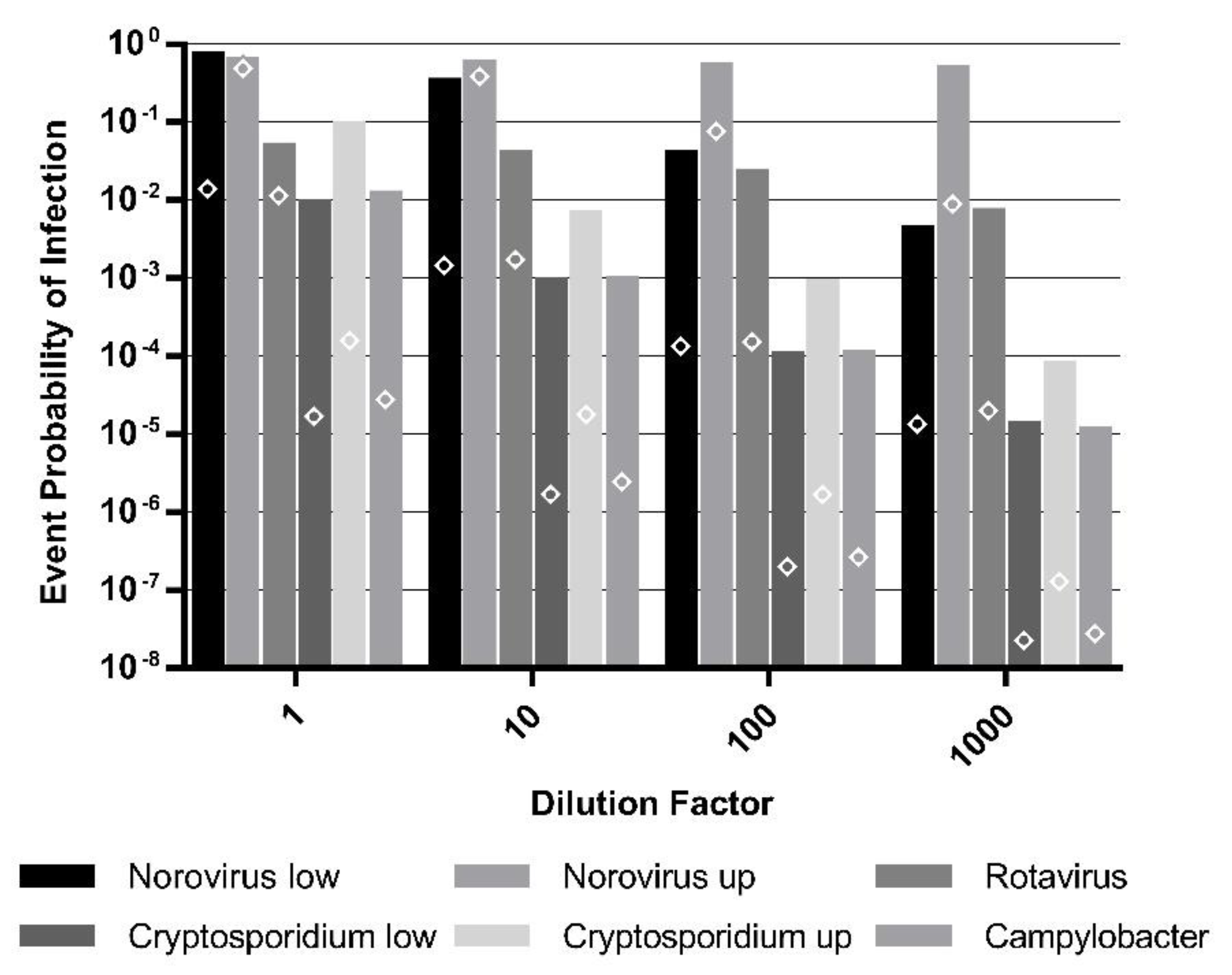
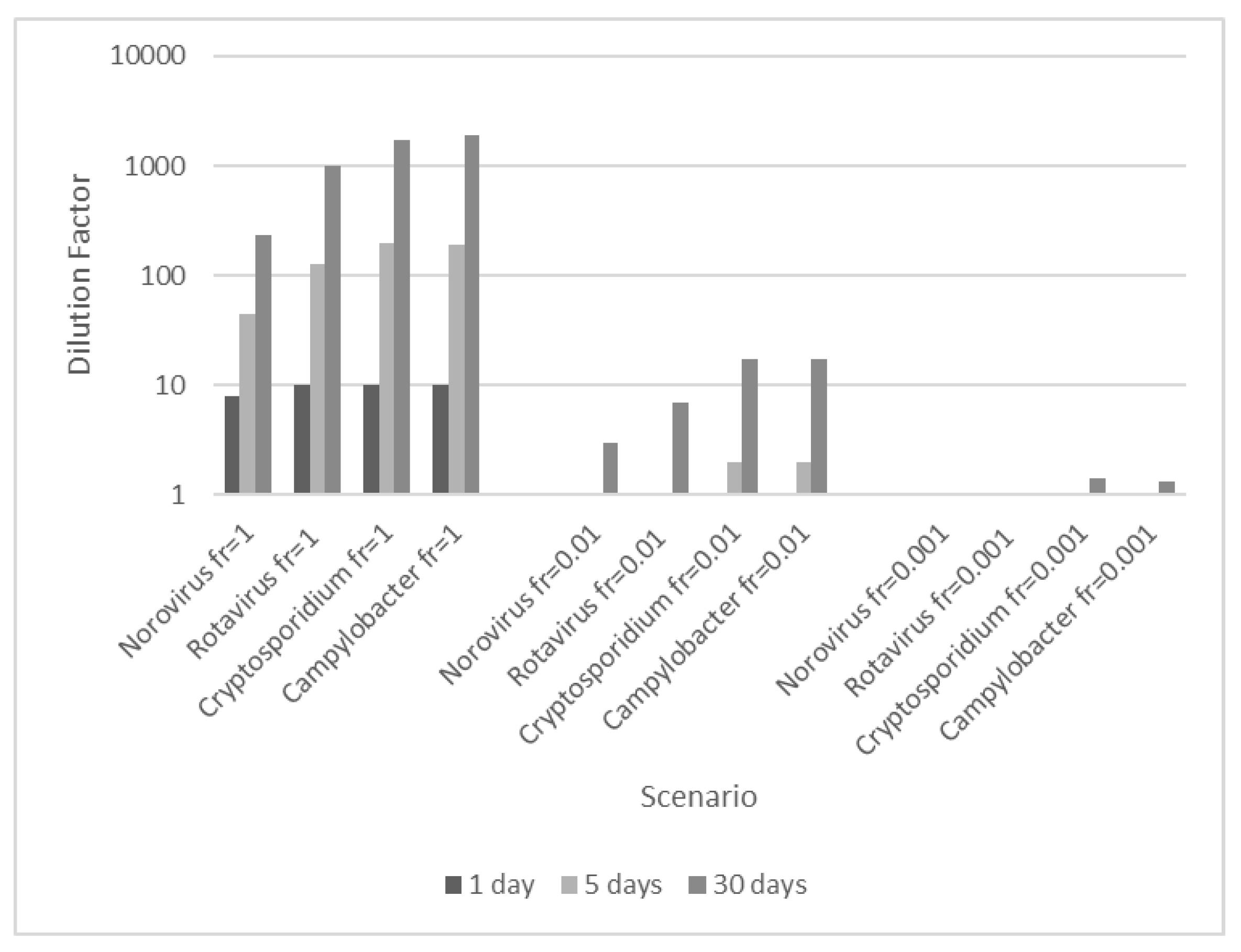
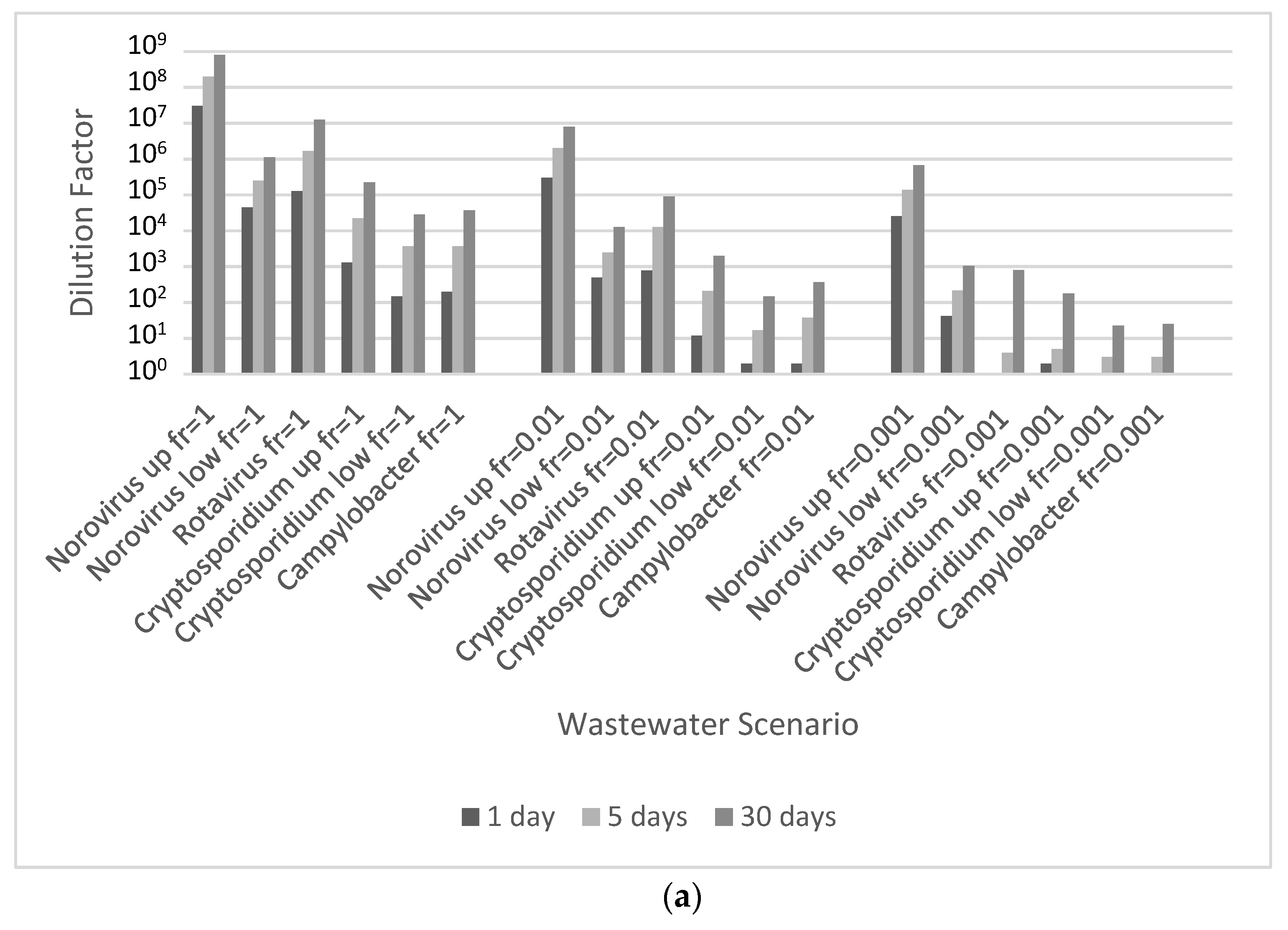
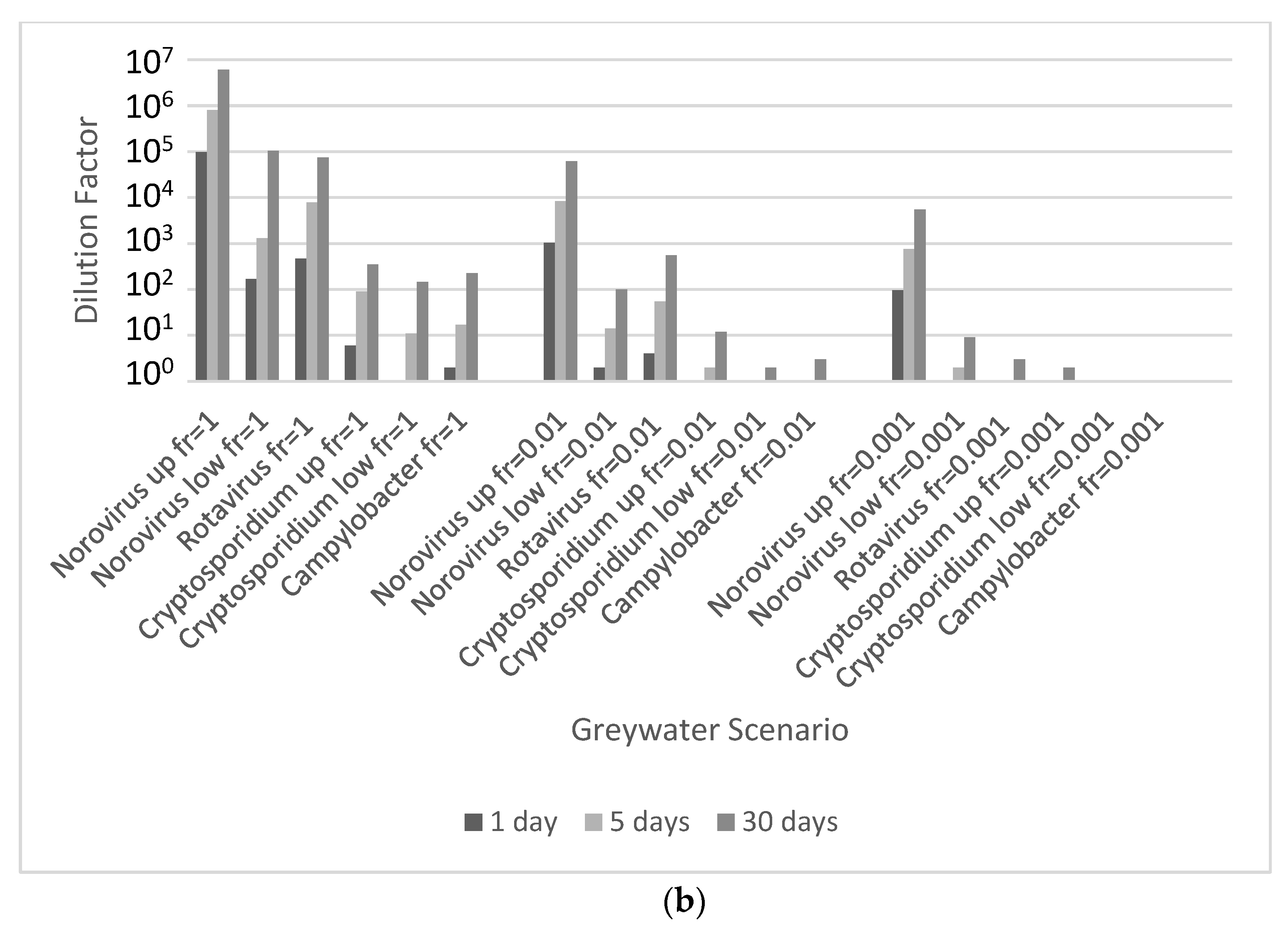
| Norovirus (Genome Copies) b | Rotavirus (FFU) | Cryptosporidium (oocysts) b | Giardia (Cysts) | Campylobacter (CFU) | Salmonella (CFU) | |
|---|---|---|---|---|---|---|
| Wastewater 1000-person collection | ||||||
| Indoor use with CC a | 11.2/8.4 | 8.8 | 6.8/5.9 | 6.1 | 6.0 | 3.8 |
| Indoor use without CC | 9.8/7 | 8.1 | 6.3/5.4 | 5.0 | 5.5 | 2.9 |
| Greywater 1000-person collection | ||||||
| Indoor use with CC a | 8.8/6.0 | 6.4 | 4.5/3.6 | 3.8 | 3.7 | 1.6 |
| Indoor use without CC | 7.9/5.1 | 6.0 | 4.1/3.2 | 3.4 | 3.3 | 0.7 |
© 2018 by the authors. Licensee MDPI, Basel, Switzerland. This article is an open access article distributed under the terms and conditions of the Creative Commons Attribution (CC BY) license (http://creativecommons.org/licenses/by/4.0/).
Share and Cite
Schoen, M.E.; Jahne, M.A.; Garland, J.L. Human Health Impact of Cross-Connections in Non-Potable Reuse Systems. Water 2018, 10, 1352. https://doi.org/10.3390/w10101352
Schoen ME, Jahne MA, Garland JL. Human Health Impact of Cross-Connections in Non-Potable Reuse Systems. Water. 2018; 10(10):1352. https://doi.org/10.3390/w10101352
Chicago/Turabian StyleSchoen, Mary E., Michael A. Jahne, and Jay L. Garland. 2018. "Human Health Impact of Cross-Connections in Non-Potable Reuse Systems" Water 10, no. 10: 1352. https://doi.org/10.3390/w10101352
APA StyleSchoen, M. E., Jahne, M. A., & Garland, J. L. (2018). Human Health Impact of Cross-Connections in Non-Potable Reuse Systems. Water, 10(10), 1352. https://doi.org/10.3390/w10101352



